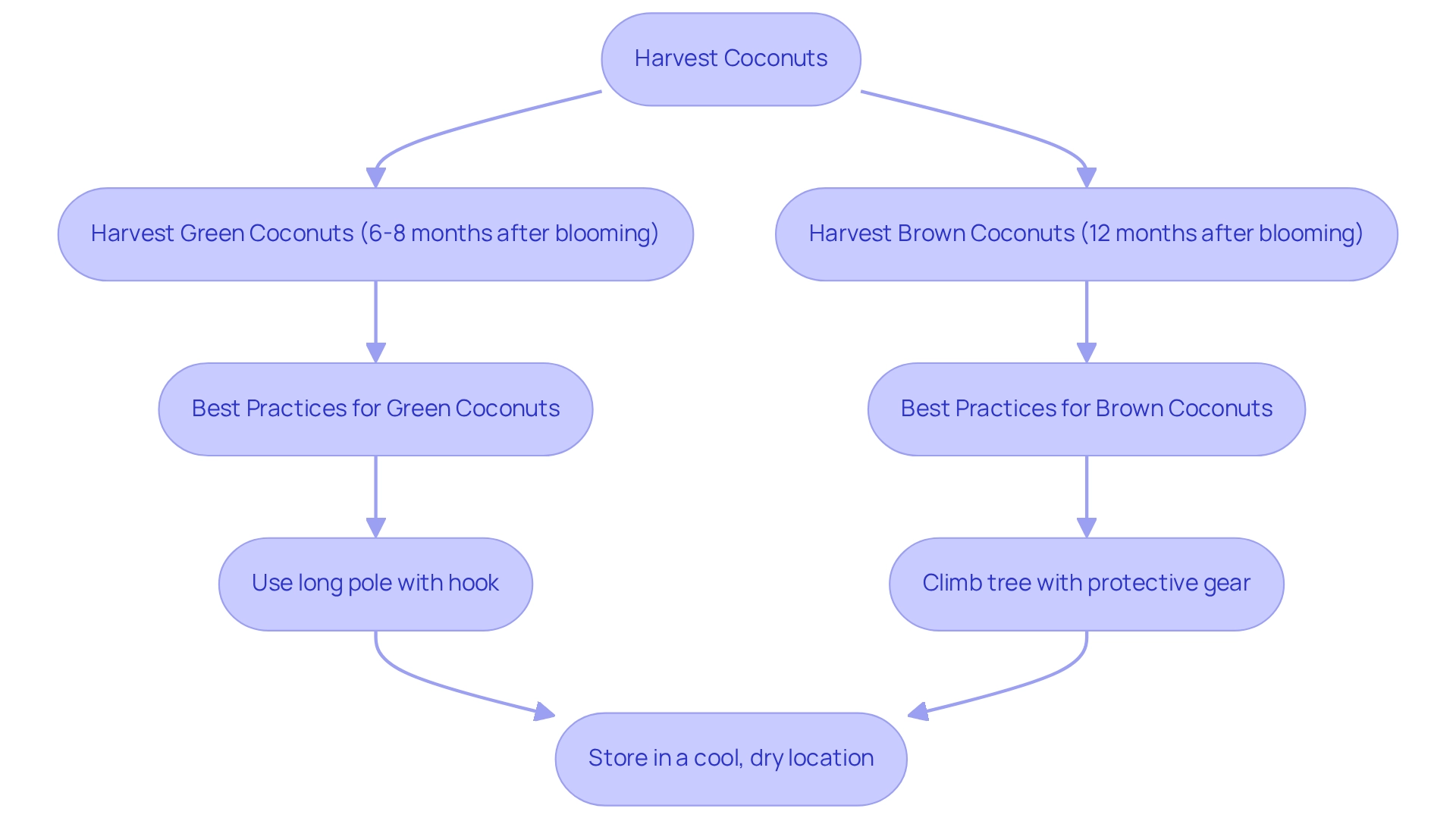Growing a green coconut tree can be a rewarding journey, but it often comes with its own set of challenges. Understanding the climate and soil requirements is essential, along with proper planting techniques, consistent maintenance, and timely harvesting. Imagine nurturing your tree as it reaches for the sun, knowing that each step you take is vital to its health.
To cultivate healthy coconut trees and achieve optimal fruit quality, it’s important to ensure your tree receives adequate sunlight and moisture. Think about the right soil that will nourish it and the effective pest management strategies that will protect it. These elements are not just technical details; they are the heart of your gardening experience, guiding you toward success.
As you embark on this journey, remember that every gardener faces hurdles along the way. By focusing on these essential steps, you can overcome those challenges with confidence. So, let’s embrace this nurturing process together, and soon you’ll be rewarded with the fruits of your labor. Are you ready to take the next step in growing your coconut tree?
👉 Get your Green Coconut Palm Malayan Tree from Everglades Farm — shipped fast and ready to thrive in your garden or patio.
The Green Coconut Palm Malayan Tree doesn’t just bring island vibes to your yard—it rewards you with sweet coconut water and lush, exotic beauty.
Understand Climate and Soil Requirements
The green coconut tree thrives in tropical climates, flourishing in temperatures ranging from 70°F to 95°F (21°C to 35°C). The green coconut tree requires at least six hours of full sunlight each day and prefers well-draining sandy or loamy soil with a pH level between 5.5 and 8.0.
Before you sow, it’s important to consider your local climate and soil conditions. Are you in an area prone to frost or harsh cold? If so, think about growing your green coconut tree in containers, allowing for easy indoor transfer during the chillier months. Moreover, selecting a planting location that avoids waterlogging is crucial. These palms are sensitive to stagnant water, which can hinder their growth and overall health.
By choosing palms from Everglades Farm's Fast-Growing Plants collection and using our professional-grade fertilizers, you can significantly boost your gardening success. Maintaining these ideal conditions will greatly enhance your chances of cultivating a healthy palm. Remember, gardening is a journey, and with care and attention, you can create a
thriving oasis right in your backyard.
To plant a green coconut tree, let’s start by selecting a healthy fruit that has water sloshing inside. Soaking the fruit of the green coconut tree in water for three days can help promote germination, giving it the best chance to thrive.
Whether you choose a well-draining pot for your green coconut tree or a sunny outdoor spot, having the right environment is key. If you decide to use a container, a blend of potting medium and sand works wonderfully for growing a green coconut tree. When you place the nut of the green coconut tree on its side, make sure to only cover half of it with soil.
After sowing, water the green coconut tree thoroughly and keep the soil consistently moist—just avoid making it soggy. If you’re planting the green coconut tree outside, ensure the location receives full sunlight and is protected from strong winds.
For those of you looking to expand your tropical garden, why not consider cultivating soursop and passion fruit as well? When
planting soursop, it’s essential to choose a sunny spot with well-draining earth and to ensure consistent watering. For passion fruit vines, providing a trellis for support is important, and keeping an eye out for pests will help ensure healthy growth.
Remember, gardening is a journey, and each step you take brings you closer to a vibrant, thriving garden.
Maintain and Care for Your Coconut Tree
Green coconut trees truly thrive when given consistent care, particularly in terms of watering and fertilization. During dry spells, it’s vital to water deeply once a week, allowing the soil to dry slightly between waterings to prevent root rot. Research indicates that palm plants require about 1 to 2 inches of water weekly, depending on environmental conditions. Fertilization should occur every two to three months using a balanced fertilizer specifically formulated for palms, which nurtures healthy growth and fruit production. In fact, 79% of reviews rate Everglades Farm's service as five stars, a testament to the quality of their products that contribute to successful palm care.
Monitoring for pests is also essential; common threats include spider mites and scale insects. If you spot these pests, treatments with insecticidal soap or neem oil can effectively manage infestations. Regularly trimming dead fronds from the green coconut tree not only enhances airflow but also reduces the risk of disease, promoting a healthier green coconut tree overall. Green coconut trees need full sunlight for optimal growth, so ensure they are placed in a spot that receives ample light throughout the day.
Additionally, keep an eye out for signs of nutrient deficiencies, such as yellowing leaves, and adjust your care regimen accordingly. Seeking
guidance from regional agricultural specialists can provide personalized recommendations on the best methods for palm cultivation, ensuring your plant remains healthy and fruitful. Moreover, initiatives like the Sustainable Coconut Charter encourage sustainable practices in palm farming, which can be beneficial for home gardeners looking to grow their trees responsibly.
Harvest Coconuts at the Right Time
Coconuts can be harvested at different stages depending on their intended use, making timing crucial for optimal quality. For those seeking the refreshing water of the fruit, the best time to gather is when the fruits are still green, roughly six to eight months after blooming. This stage ensures the water is sweet and invigorating. On the other hand, if your goal is to enjoy the rich flesh of mature fruits, wait until they turn brown, which occurs approximately 12 months after blooming.
When it comes to harvesting, employing the right technique is essential. Utilizing a long pole with a hook is a common method, allowing you to access fruit without climbing the tree. If climbing is necessary, please prioritize safety by wearing protective gear to shield against falling fruits.
After harvesting, proper storage is vital to maintain freshness. Keep the fruits in a cool, dry location to extend their shelf life. Understanding these best practices not only enhances the quality of the fruits but also promotes sustainable harvesting techniques, nurturing the overall health of palm cultivation. Additionally, it's important to recognize that the wild fruit has a solid endosperm that is only 12 mm thick, which can influence the quality of the fruit's meat. Recent studies highlight the need for a deeper understanding of
palm propagation techniques, emphasizing the significance of biological traits in refining harvesting practices. Expert insights, such as those from Steve W Adkins, suggest that proper timing and techniques are crucial for successful coconut harvesting. By following these guidelines, you can cultivate high-quality green coconut trees, which will support both your gardening journey and the environment.

🌱 Ready to Grow a Green Coconut Tree?
With the right care, you’ll be sipping fresh coconut water from your own backyard.
👉 Shop the Green Coconut Palm Malayan Tree now and start your tropical gardening journey with Everglades Farm.
Frequently Asked Questions
What climate is suitable for growing green coconut trees?
Green coconut trees thrive in tropical climates with temperatures ranging from 70°F to 95°F (21°C to 35°C).
How much sunlight do green coconut trees need?
They require at least six hours of full sunlight each day.
What type of soil is best for green coconut trees?
Green coconut trees prefer well-draining sandy or loamy soil with a pH level between 5.5 and 8.0.
What should I consider before planting a green coconut tree?
Consider your local climate and soil conditions, especially if you are in an area prone to frost or harsh cold.
How can I protect my green coconut tree from cold weather?
If you live in a colder area, consider growing your green coconut tree in containers for easy indoor transfer during chillier months.
Why is it important to avoid waterlogging when growing green coconut trees?
These palms are sensitive to stagnant water, which can hinder their growth and overall health.
How can I improve my chances of successfully growing a green coconut tree?
By selecting palms from a reputable source like Everglades Farm's Fast-Growing Plants collection and using professional-grade fertilizers, you can significantly boost your gardening success.
What is the overall goal of maintaining ideal conditions for green coconut trees?
Maintaining these ideal conditions will greatly enhance your chances of cultivating a healthy palm and creating a thriving oasis in your backyard.









0 comments